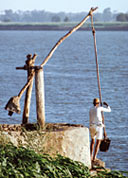Here is what I have learned about “simple machines”.
 A simple machine is a mechanical device that changes the direction or magnitude of a force. In general, they can be defined as the simplest mechanisms that use mechanical advantage (also called leverage) to multiply force. A simple machine uses a single applied force to do work against a single load force.
A simple machine is a mechanical device that changes the direction or magnitude of a force. In general, they can be defined as the simplest mechanisms that use mechanical advantage (also called leverage) to multiply force. A simple machine uses a single applied force to do work against a single load force.
Usually the term refers to the six classical simple machines which were defined by Renaissance scientists: Lever, Wheel and axle, Pulley, Inclined Plane, Wedge, Screw
They are the elementary “building blocks” of which all complicated machines are composed. For example, wheels, levers, and pulleys are all used in the mechanism of a bicycle.
Simple machines fall into two classes; those dependent on the vector resolution of forces (inclined plane, wedge, screw) and those in which there is an equilibrium of torques (lever, pulley, wheel). (Yes, I had to look up some of these terms!)
The idea of a “simple machine” originated with the Greek philosopher Archimedes around the 3rd century BC, who studied the lever,
pulley, and screw. Heron of Alexandria (ca. 10–75 AD) studied the winch, lever, pulley, wedge, and screw. During the Renaissance simple machines (excluding the wedge) began to be studied as a group. The complete dynamic theory of simple machines was worked out by Italian scientist Galileo. He was the first to understand that simple machines do not create energy, only transform it. (Wikipedia)
From this information there are tremendous possibilities for Spark Station additions. Add new tools to your box; screwdriver, plane, wedge and screws. That stump is going to come in very handy. Even I would find planning off bark to be enjoyable. I like putting screws in. It’s fun. If you have older children why not have dad help them make something using these tools, a small book shelf for example. None of these things have to be complicated. You are introducing new concepts. The shelf isn’t important in how it turns out. It matters because it gives your child an opportunity to see the concept in action.
One Christmas I helped my then nine year old son make foot stools for his grandparents. We got cheap scrap lumber from the lumber yard. We used a wide piece for the foot rest and pieces of 4×4 for the legs. He used tools to attach the legs to the foot rest. Then he planned it off, sandpapered it smooth and we covered it with padding and some vinyl scraps from an upholstery shop. We could have painted it instead. I know very little about building but it was a great success.
Perhaps you don’t think too much about using mechanical advantage but there’s no way you can live through a day without utilizing it in some way. Levers are everywhere; the light switch on the wall, for example, and the stapler on your desk. You use levers when you shift gears on a bike and when you hit the brakes. A doorknob is a type of lever. And then there’s your body. Your body contains many, many levers—wherever there’s a movable joint there’s a lever.below.
You can find a very good illustration of this principle at this site:
http://www.pbs.org/wgbh/nova/egypt/raising/lever.html
Whenever you pick up anything heavy, your elbow acts as the fulcrum of the lever, and your arm bone acts as the lever itself.
Some kinds of animals figured out how to use artificial levers to get work done. Sea otters, for example, use rocks to pry open seashells to get sea urchins or abalones to eat. Orangutans use sticks to pry open pieces of spiny fruit to eat the seeds inside.
seashells to get sea urchins or abalones to eat. Orangutans use sticks to pry open pieces of spiny fruit to eat the seeds inside.
You can find pictures of animals using tools and levers on line or in the library.
People have probably used levers as long as there have been people on earth. At first, people used levers the way otters and orangutans do, to break into shells and fruits to eat the food inside.
 By the time people were living in cities they used levers for many more things. Take a look at a shaduf. It is a very important tool for lifting water in many countries.
By the time people were living in cities they used levers for many more things. Take a look at a shaduf. It is a very important tool for lifting water in many countries.
Can you see in the information above all the possible conversations, activities and information that can be put into The Spark Station and shared with your children? If you are showing them a picture of a shaduf then you can give them information about countries where they are used. Then you can find those counties on a map and learn about them. You can make the food they make, see how they dress, what school is like, what families are like. You can make a simple shaduf.
You can do experiments with the levers in your body. You can have a leg wrestling contest. You can play the game of stick pulling. You can study animals that use levers. What else do those animals do? Where do they live?
You can expand your study of levers into the other simple machines, wheel and axle, pulley, inclined plane, wedge, screw. Where can you find them around your home, in your environment? Can you make some of them? Can you use them and talk about how they make life easier? Can you see how one spark of an idea can lead you to dozens of others; how just a bit of thinking time can give you weeks and months of ideas to work with.
What if all you did for 6 months was build, identify, use and learn about simple machines. Wouldn’t your children have learned a whole lot about a very important scientific principle and had a lot of fun doing it. Wouldn’t they have learned about the mathematicians who came up with all the ideas and theories? It doesn’t matter if they are 4 or 12, you will have planted tons of seeds, learned things for yourself and inspired your children. Now go do it!
Possibly Related Posts:
- Inspiring Learning
- Family Philanthropy Project – How to Grow Your Family’s Heart by Jodie Palmer
- Science of making Ice cream with liquid nitrogen
- Fun activities for afterschooing and for homeschoolers
- HELP! Activities and games for small children




{ 1 comment… read it below or add one }
Oh, this is great! I had camp with my Grandsons last summer and spent two days on Ancient Egypt. They are eager for more, so this info on levers will be most welcome!!! Great site!!